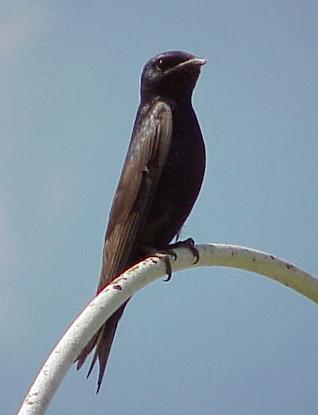

North America is blessed with a large number of different swallow species and
some form of them can be found just about everywhere.. Of these, the
Purple Martin is the largest member. Within the martin family of North America,
there are three distinctly different subspecies, each having their own unique
nesting habits.
In the Pacific Northwest can be found the progne subis arboricola. These birds once used the natural cavities in trees in which to nest in the wild, but are now beginning to use individual nesting boxes placed on poles by man. The transition is slow, but little by little, this species is beginning to seek these boxes out at nesting time.
In the Desert Southwest, progne subis hesperia still uses natural nesting sites such as holes in cacti. They have yet to make the transition over to man made nesting boxes.
And finally for us here in the Eastern half of the U. S., there's our very own, progne subis subis. This species encompasses the entire eastern U.S. ranging from the Florida Keys all the way northward into parts of Canada. Over generations this species, for the most part, has developed a total dependence on man to supply them housing in which to nest. In general, it will be this species that this page is devoted to.
Introduction:
Purple Martins are the largest member of the swallow family with mature birds measuring up to 8 inches long. The tips of their extremely well developed wings often reach beyond the ends of their tails. Their tails are slightly forked when in flight. They are master fliers which probably accounts for their superb wing development. They have a short, flat, triangular shaped bill which is ideal for catching insects while on the wing. They fly with an alternating flapping-gliding motion and are able to make very quick directional changes which allows them to catch their prey. Purple martins glide more than any other member of the swallow species.
Martins are Neotropic in nature and migrate south each winter to South America (Brazil and surrounding areas) each year. They do not nest while in their wintering grounds. Instead, they use this time to put on a whole new coat of feathers. (All birds molt at least once every year to renew their feathers). About late Dec or early Jan, they begin returning to the very southern states to begin nesting. The migration moves northward as the weather warms and the flying insect population is adequate enough to keep them fed. Purple martins have a very strong site tenacity and will usually return to the same site where they successfully fledged young from the previous year. The males usually arrive first and stake claims on the best nesting cavities and then try to attract newly arriving females to pair with them and raise a brood. Although not always, if successful in raising a brood, the same birds (if surviving the winter) will often pair the following year and even use the same cavity if still available. Martins are communal nesters and seek out other martins when looking for nesting sites. Males attempt to attract other males so that they may potentially breed with the females that they in turn attract. (A term known scientifically as 'forced pair copulation'). New sites are started by offering housing that has at least a minimum of six cavities so there is room for the colony to grow. If the site is suitable, any birds looking for a nesting place will often take up residence. The colony then grows as males try and attract other birds to stay.
Identification:
Distinguishing the different sexes and ages of martins can be very difficult for the inexperienced landlord. Unlike most birds, martins do not obtain their mature coloration until they are a full 2 years old, (a term known as 'delayed plumage maturation'). By far the easiest to recognize is the adult or ASY (After Second Year) male. As can be seen here, the mature male purple martin is a beautiful bird, fully cloaked in black-purple feathers. His entire body has feathers that have a purplish hue to them. Depending on how the light hits him, his back, neck and chest feathers are the most distinguishable. It's this steel blue iridescence which can be seen when sitting in the proper light and where the species gets its name. Only mature males attain this entire black plumage.
|
|
|
|
Mature Male Purple Martin |
Sub-adult Male Purple Martin |
Immature or sub-adult males (also known as SY or Second Year) do not have the full black body dress of the adults and must wait until they are in their second breeding year to obtain it. Instead, they sport an erratic display of purple feathers on their chests, ranging from some like the one shown above to some that will have only one or two purple feathers on their chests. The majority of the time they only have one or two of these feathers and it's these males that are so hard to tell apart from the females. It takes a good amount of studying the birds up close to become proficient at telling the difference and often, other points are needed to tell that they are males. Also, a good pair of field glasses will come in very handy at times. Here are a couple more to help.
|
|
|
|
Sub-adult Male Purple Martin |
Sub-adult Male Purple Martin |
These 'subby' males have a few good purple feathers speckling their chests making it easy to tell that they are sub-adult males. And yes, you'll see some with even less making it just about impossible to tell them from the females.
Females do not have entire bodies of black like the males and never attain this feature. (A term known as Sexually Dimorphic). Instead, they are much duller than the mature males and always have a somewhat white to grayish mottled belly. ASY females will usually have a little darker breast and their feathers will normally have a little more even pattern to them.
|
|
|
|
Adult Female |
Sub-adult Female |
One of the things that new landlords have difficulty with is being able to distinguish the difference between the females and the less speckled sub-adult males and many mistake their young colonies for being all female and wondering how they can attract some males. But what most of them don't realize is that the males usually come to a site first and then attract the females. Males will select what they consider to be the best of the available compartments in a site and then attempt to attract females to the compartments that they've selected. One way that helps differentiate the sub males from the females is the throat and head cap areas. The throat area is usually darker on the males than on the females. Also, the tops of the heads of the SY males are usually capped with the black iridescent feathers that the males sport.
However please note: As the females get older, their plumage generally gets darker and this again makes it even more difficult to tell them apart.
Another method of telling them apart, the males will 'chase' after females, calling to them as they go. This chasing is part of the mating ritual and is used to draw her to the site to stay.
One definite way of telling the SY males from the females is their call. All males will end their low guttural call with a distinctive "rrrriikk" while the females will not. Once heard, the purple martin's call is very distinctive and immediately noticed when they return each spring.
Martins are gregarious in nature and prefer to nest in groups. They are strictly cavity nesters and will seek out suitable cavities in which to raise their young. Through years of generational imprinting and nesting around man, the eastern species has made a complete transition from nesting in the wild to nesting in man made 'condo' units and are now totally dependent on man for their housing requirements. (A term known scientifically as 'behavioral pattern shifting'). These man-supplied houses usually have 6 or more individual cavities to start with and often have as many as 20 or even 30 cavities in each house. Although sometimes difficult to get a colony started, once established, the colony will grow year after year as long as there are nests available to them. Colonies of 200 and 300 nesting pairs are not unheard of, although the norm is more like 6 to 10 nesting pairs in the average established site. Martins have a very strong "site tenacity" and if are successful in raising a brood, will often return to the same site to nest year after year.
Once a colony is established, 'landlords', (people that keep purple martins) become very attached to their birds and often go out of their way to help defend and care for them. Because of their style of nesting, martins are often at the mercy of many predators and pests and each has to be defended against in its own way. It's the responsibility of the landlord to see to it that they are safe and un-harassed so that they can successfully raise their broods.
Nesting and Nest Identification
Martins are cavity nesters and will usually take about 1 to 2 weeks to build a low profile nest using sticks, twigs, bits of straw, pine needles, leaves or whatever's available. Displaying a 'typical' martin nest is difficult in that the materials used will totally depend on what part of their range they are nesting in. They'll use just about what ever materials that are available in their area so it would be difficult to show a single nest that would describe them all. Below is a nest that was built in a colony in Florida. Wheat straw and dried leaves were the preferred materials for that area.
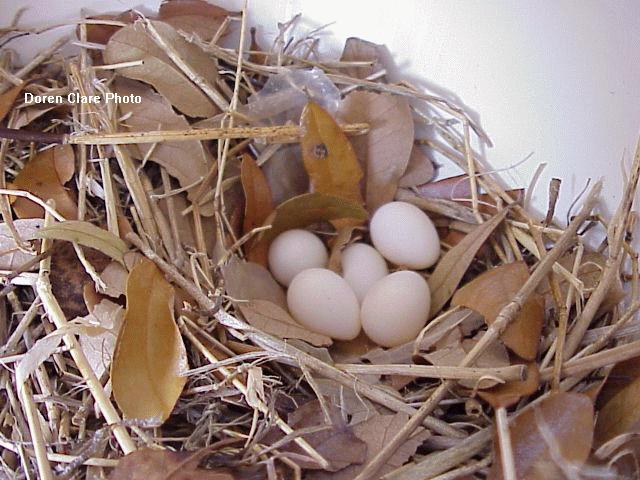
The nest below is one from my own colony in northern Alabama. As you can see, fresh leaves are the order for the day. We have many colorful and ornamental trees in this area and even those fit right in.
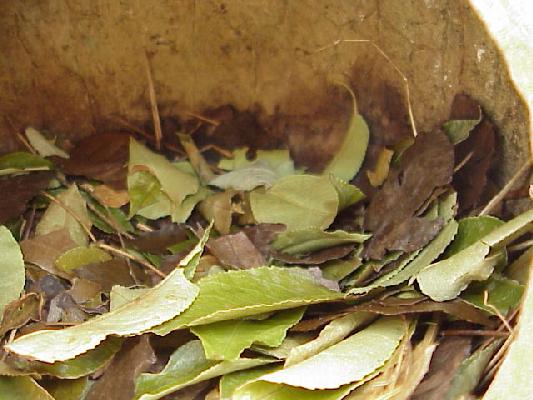
Nests materials may be different from area to area, however, one thing that usually stands out is that they will almost always use freshly picked leaves of some kind to line their nest bowls. Some nests might not have a lot of them, but they are almost always present to some degree. Some nests may contain only two or three, while others will be piled in such as the one shown above. Martins will begin the nest with straw or sticks of some sort and in some of the cases, depending on the birds and the availability of it, there will even be mud thrown in, usually forming a small dam right in front of the entrance hole. Below is such a nest and again, depending on the birds, there can be a small dam as the one shown here, while others will build a massive fortress just inside the front entrance hole. One thing I've noticed is that these mud dams are usually only present in the smaller compartments. The larger a compartment is, the fewer of these dams are present.
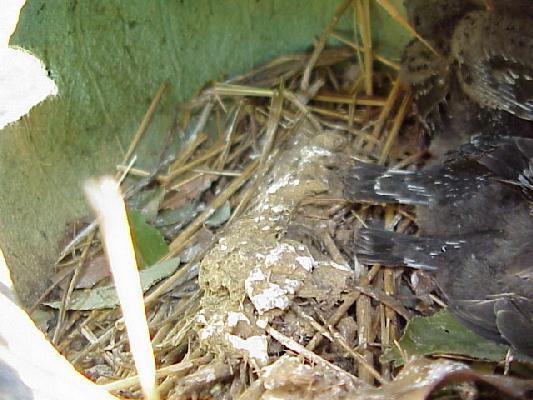
Eggs
In the back of the nest the female forms a bowl and lays from 3 to 7 soft white eggs with the norm being 4 or 6. Immature birds usually lay from 2 to 5 eggs while the more mature birds, 4 to 7. Notice here this nest contains pine straw (dried pine needles) and is lined with nice fresh green leaves for softness. The reason for the green leaves is not fully known yet, but it's thought they are used to keep the eggs moist.
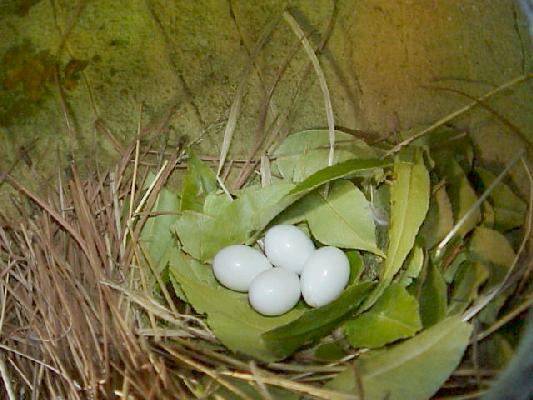
Incubation lasts from 15 to 17 days with the female doing most, if not all the work. The female develops a 'brood patch', (an area on her breast that is void of feathers) and uses this patch to transfer heat from her body to the eggs. The young are Altricial, (birds born without feathers and develop in the nest) and take about 28 to 32 days to fully develop and ' fledge' or leave the nest. This is a frenzied time in the colony with adults coming and going, bringing food to the ever hungry mouths. About 3 or 4 days before the young are about ready to fledge, the adults slow down feeding drastically. This forces the young lose a small amount of weight. This weight loss has a two-fold effect. One, it makes them want to get out of the nest and fly and get fed and two, it makes them light enough so that those first flights are successful. It's crucial that young martins learn to fly well and to do it quickly. Their lives depend on it. Many predators are waiting for these young and inexperienced birds to leave the nests so that they can catch and feed on them.
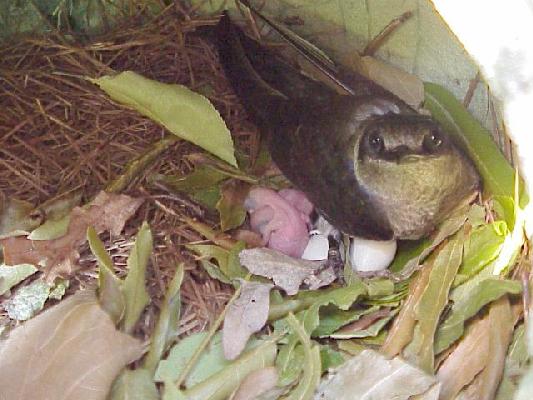
The following sequence of pictures should help with 'approximate' dating of young. They are approximate because different birds will develop at slightly differently rates.
|
|
|
Freshly hatched young purple martins |
|
|
|
3-5 days. Pinfeather coloration beginning |
|
|
|
7-10 days. Pinfeathers begin to pop, eyes are open |
|
|
|
15-20 days. Feathering is beginning to take shape. |
|
|
|
25-32 days. A young fully feathered purple martin, just about ready to fly. |
|
|
|
HY (Hatched Year) fledgling on left, mom on right. |
Notice the white breast and almost white throat area on the young bird. At this age, the sexes are indistinguishable.
Once leaving, the young may return to the nest for a few nights, after which they will start spending all their time with the adults. The adults will continue to feed the young for a few days until they have acquired enough skill to catch their own food. The young will then join the adults in small pre-migratory roosts where birds will begin to congregate preparing for the flight south. Shortly after becoming independent, the parent-young bond dissipates and the young are now totally on their own.
For the most part, insects make up the majority of the martins diet. They can often be seen high in the sky on early morning and late afternoon thermals, dipping and diving, snatching insects out of the air. Insects on the menu are flying ants, beetles, butterflies, damselflies, dragonflies, mayflies, moths, stinkbugs, wasps, a few houseflies. Out of all of these, their favorite food is probably the dragonfly. During year end nest cleaning, the compartments are littered with dragonfly wings and skeletal parts.
|
|
|
Purple Martins love Dragonflies |
One myth about martins is that they consume thousands of mosquitoes each day. Not true according to studies done on the diets of martins. Mosquitoes make up less than 2% of the martins diet and if you stop and use a little common sense, this can be figured out on your own. Martins generally feed high in the air, around the 300 or 400 foot level and even as high as 1000 feet, while at the same time, mosquitoes usually stay within 15 to 20 feet of the ground where it's moist, therefore, the two seldom cross paths. Now, if a mosquito happens to be in the path of a martin, the martin will probably take it, but martins do not go looking exclusively for them. One reason is, the amount of energy spent in gathering mosquitoes would far out way the nutritional benefits and, if you stop to think about it, mosquitoes become most active at dusk, about the same time martins and other birds go to bed.
Martins, as with all the
swallow family, drink and bathe on the wing, therefore a good fresh water supply
is required somewhat nearby. This water source could be within 2 miles of
the site. This means either a lake or pond of some sort or an open stream
or river. Although it has been noted that martins will use a large
swimming pool for a quick dip or drink, they will not use a source such as a
bird bath. Martins will not land to drink or bathe.
|
|
|
Purple martin taking a bath. |
For a more detailed description of the daily habits of purple martins, go to the Habits Page
Since martins eat only insects, they have to migrate to continually have a
supply of food. Their range is throughout most of the Eastern U.S. and Canada
with some migration up the west coast of the U.S. Around the end of summer, after
the young have fledged and are capable of taking care of themselves, they can be
seen congregating into large flocks of thousands of birds, preparing themselves
for the long migration south. Each year wave after wave of martins make the trek
from North America south to Brazil and surrounding areas in South America. They
make the trip either via Central America or down the Florida peninsula, through
the Florida Keys and Bahamas and across the Gulf of Mexico to South America.
Martins are good fliers, and under normal circumstances the trip is not too
hazardous, but a large storm in the Gulf of Mexico at the wrong time can
devastate a migrating flock.
Martins are a protected species under the Federal Migratory Bird-Treaty Act,
thus it is illegal to harm the birds, their nests or any other part of their
habitat. It is also illegal to trap or possess these birds without proper
permits from the U.S. Fish and Wildlife Service.
In the following map, the shaded area indicates the overall northern range of the Purple
Martin, and the cross lines indicate the approximate arrival of the 'scouts'
(first returning birds) in a
given area. These dates are only approximate and may vary by as much as a
couple of weeks either way depending on weather conditions for any given year.
|
| |
|
artwork courtesy J. Hill III |
|
There is no real benefit to erecting and maintaining a purple martin site other than the shear enjoyment of it. They are a delightful bird to have around and are actually friendly towards man, allowing the inspection of their nests without any apparent negative effects to the birds. When the nests are put back up in place after inspection the parent birds soon return to their daily activities as if nothing ever happened. Sitting back and watching their antics throughout the day is a pleasant and relaxing past time. In fact, in time, you'll catch yourself spending more and more time watching and enjoying them.